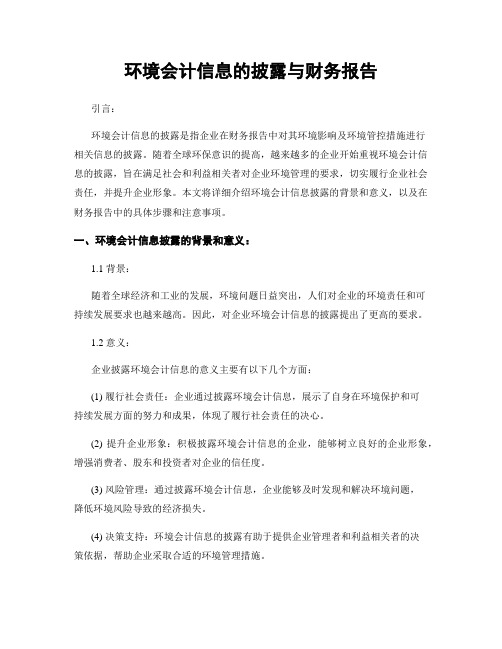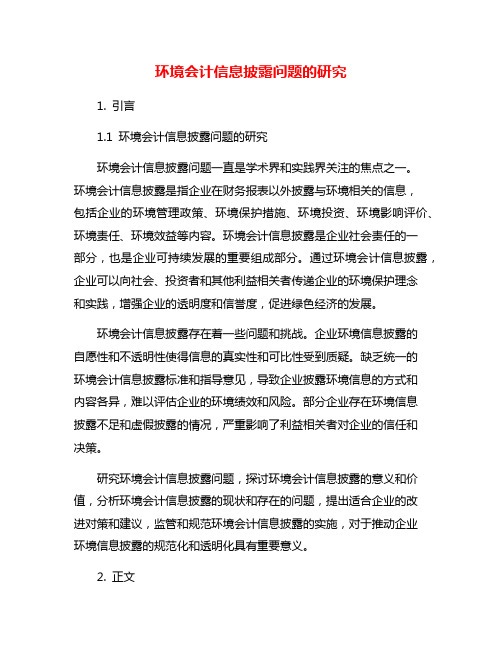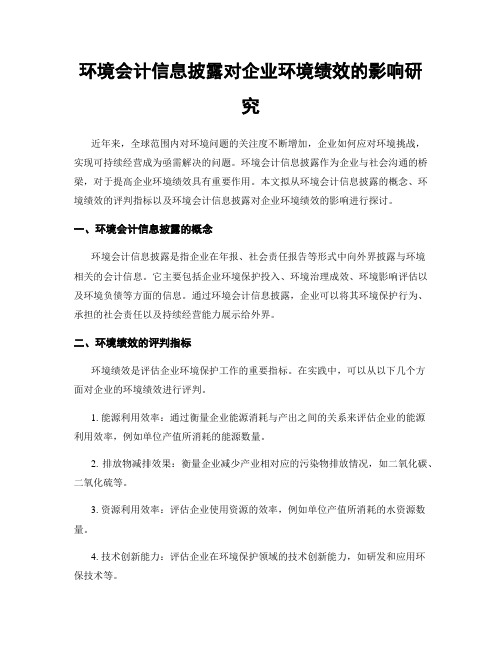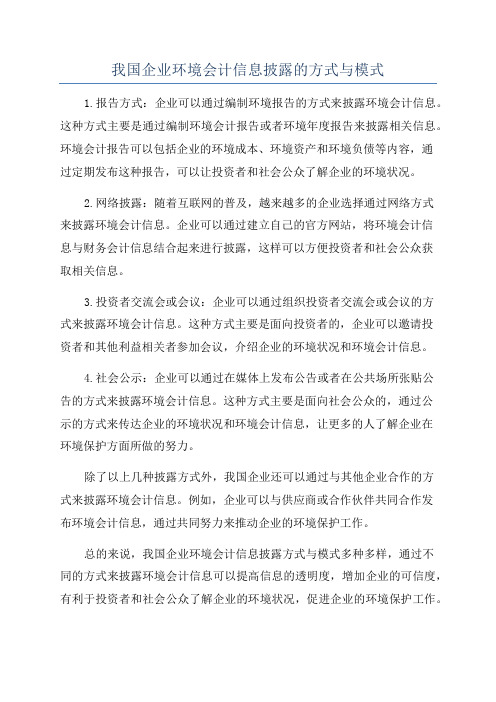环境会计信息披露
我国石油企业环境会计信息披露问题及策略

我国石油企业环境会计信息披露问题及策略作者:王璐来源:《现代企业》2024年第02期近年来,环境污染已经成为人们最关心的问题之一,因为很多人的疾病都是由环境污染引起的,这其中最重要的因素就是企业的生产经营活动,特别是像石油天然气等重污染企业。
随着企业的不断发展,企业环境会计信息的披露也引起了更多人的注意。
一、关于环境会计信息披露的概述1.环境会计的概念。
环境会计,又被称为绿色会计,是企业会计的一个分支,它的目标是以有关的会计理论和方法为基础,利用各种特征和测量方法,对与环境保护有关企业的全部经济活动进行记录和控制。
它是一种以货币为计量依据,按照有关法律、法规的要求,准确地反映、评估企业在环保活动中的收入与费用;与此同时,它还对企业与环境有关的财务状况以及经营成果进行评价,是一门新兴的学科,也是未来公司财务报表中不可缺少的一部分。
环境会计力图将传统会计与环境经济学相结合,利用价值评估体系对企业展开有效的管理,在不影响企业自身发展的前提下,对环境进行保护,从而达到经济目标与自然环境和谐发展的目的。
2.环境会计信息披露的概念。
环境会计信息披露指的是通过企业的年度报告、社会责任报告和可持续发展报告等方式,对企业在环境方面的业绩进行披露,使有关信息的用户能够更好地理解企业在环境方面采取的具体措施以及产生的效果。
它所公开的信息包含了企业环境的定量信息和非定量信息,以及企业的财务信息与非财务信息。
环境会计信息的根本任务是保证信息内容的完整性、可靠性和准确性,使之能反映出环境会计过程的最后成果。
3.环境会计信息披露的内容。
环境会计信息的披露环节,能使公众更好地了解到企业社会责任的履行情况,以及企业对经济绩效的影响。
但是,在获取信息的效率方面,不同的披露形式所产生的效果也不尽相同。
选择适当的信息披露模式可以帮助信息使用者快速、准确地获得所需的信息,进而帮助他们作出科学合理的投资决策。
现如今,一套完整的环境会计信息披露体系尚未形成,对于企业披露的格式,也没有硬性规定,公司对信息披露方式的选择具有较强的随意性,造成企业在信息披露方式上没有统一的标准。
环境会计信息的披露与财务报告

环境会计信息的披露与财务报告引言:环境会计信息的披露是指企业在财务报告中对其环境影响及环境管控措施进行相关信息的披露。
随着全球环保意识的提高,越来越多的企业开始重视环境会计信息的披露,旨在满足社会和利益相关者对企业环境管理的要求,切实履行企业社会责任,并提升企业形象。
本文将详细介绍环境会计信息披露的背景和意义,以及在财务报告中的具体步骤和注意事项。
一、环境会计信息披露的背景和意义:1.1 背景:随着全球经济和工业的发展,环境问题日益突出,人们对企业的环境责任和可持续发展要求也越来越高。
因此,对企业环境会计信息的披露提出了更高的要求。
1.2 意义:企业披露环境会计信息的意义主要有以下几个方面:(1) 履行社会责任:企业通过披露环境会计信息,展示了自身在环境保护和可持续发展方面的努力和成果,体现了履行社会责任的决心。
(2) 提升企业形象:积极披露环境会计信息的企业,能够树立良好的企业形象,增强消费者、股东和投资者对企业的信任度。
(3) 风险管理:通过披露环境会计信息,企业能够及时发现和解决环境问题,降低环境风险导致的经济损失。
(4) 决策支持:环境会计信息的披露有助于提供企业管理者和利益相关者的决策依据,帮助企业采取合适的环境管理措施。
二、环境会计信息的披露步骤:2.1 收集环境会计信息:企业需要收集包括各类环境成本和环境投资的信息。
环境成本包括直接成本和间接成本,如环境保护设备购置成本、环境治理费用、环境保护产品开发成本等。
环境投资则主要包括环境保护设施和技术研发的投资。
2.2 归集和分类:将收集到的环境会计信息进行归集和分类,确保信息的准确性和完整性。
可以根据环境成本的性质和用途进行分类,如环境污染防治成本、资源节约与循环经济成本等。
2.3 评估环境影响:评估环境会计信息对企业财务状况和经营绩效的影响。
以财务指标为基础,分析环境会计信息对企业利润、资产负债表和现金流量表的影响。
2.4 编制环境会计报告:根据归集和评估的环境会计信息,编制环境会计报告。
环境会计信息披露要点知识点总结

环境会计信息披露要点知识点总结一、环境会计信息披露的概念和重要性环境会计信息披露是指企业通过一定的方式和渠道,向利益相关者公开其在环境保护方面的财务和非财务信息。
随着全球对环境保护的重视程度不断提高,环境会计信息披露逐渐成为企业社会责任的重要组成部分。
其重要性主要体现在以下几个方面:首先,有助于提高企业的透明度和公信力。
通过披露环境会计信息,企业能够向社会展示其在环境保护方面的努力和成果,增强公众对企业的信任。
其次,促进企业的可持续发展。
环境会计信息可以帮助企业识别和管理环境风险,制定更有效的环境策略,从而实现经济与环境的协调发展。
再者,满足利益相关者的需求。
投资者、债权人、消费者等利益相关者越来越关注企业的环境表现,环境会计信息披露能够为他们的决策提供重要依据。
最后,推动环境保护事业的发展。
企业作为社会经济活动的主体,其环境会计信息披露有助于形成良好的社会监督氛围,促进整个社会的环境保护意识提升。
二、环境会计信息披露的内容(一)环境财务信息1、环境成本包括预防成本、治理成本、损害成本等。
例如企业为减少污染而投入的设备购置和运行费用、因环境污染导致的罚款和赔偿等。
2、环境收益如通过资源节约、废弃物回收利用等方式获得的经济收益。
3、环境负债企业因环境问题可能承担的债务,如预计的环境修复费用、环境诉讼赔偿等。
(二)环境绩效信息1、资源利用效率包括能源消耗、水资源消耗、原材料利用等方面的指标和数据。
2、污染排放情况如废气、废水、废渣等各类污染物的排放量和达标情况。
3、环境管理措施企业采取的环境管理制度、环保技术研发、员工环保培训等。
(三)环境政策和目标企业的环境方针、战略规划以及短期和长期的环境目标。
三、环境会计信息披露的方式(一)独立环境报告企业单独编制环境报告,全面、系统地披露环境会计信息。
(二)年度财务报告中的附注在财务报告的附注部分,对与环境相关的财务信息进行说明和解释。
(三)社会责任报告将环境会计信息作为社会责任报告的一部分进行披露。
对环境会计信息披露问题的若干思考

对环境会计信息披露问题的若干思考环境会计信息披露是指企业在财务报表中披露有关环境保护和可持续发展的信息。
随着全球环境问题日益严重,环境会计信息披露也逐渐受到关注。
对环境会计信息披露问题的思考不仅涉及到企业的社会责任和可持续发展战略,也关乎到投资者和相关利益相关方的权益保护。
本文旨在探讨环境会计信息披露问题,并提出一些思考和建议。
首先,环境会计信息披露在企业社会责任层面扮演着重要的角色。
作为企业的一项社会责任,环境会计信息披露可以帮助企业实现可持续发展目标,提升企业的社会形象和声誉。
通过披露环境信息,企业可以向社会各界展示其对环境保护的承诺和实际行动,增加社会信任度,建立良好的企业形象。
同时,环境会计信息披露也可以促进企业与相关部门、行业协会、非相关部门组织等利益相关方之间的沟通和合作,推动企业在环保方面的持续改进,实现可持续发展。
其次,环境会计信息披露对投资者具有重要意义。
投资者在进行投资决策时,需要了解企业的环境绩效和环境风险,以评估企业的长期价值和可持续性。
环境会计信息披露可以为投资者提供有关企业环境管理实践、环境成本和环境责任的信息,帮助投资者评估企业的风险暴露程度和未来发展潜力。
投资者可以通过环境会计信息披露来识别那些在环境问题管理方面具有竞争优势的企业,为其投资组合的风险管理提供参考依据。
再次,环境会计信息披露对环境保护和可持续发展具有重要推动作用。
企业对环境信息的披露,有助于提高企业对环境问题的认识和重视程度,鼓励企业加大环境保护投入,推动企业转型升级,促进绿色发展。
通过环境会计信息披露,企业可以更好地监督和评估自身的环境绩效,发现环境问题和隐患,及时采取措施加以解决,避免环境事件对企业形象和经营活动造成负面影响。
另外,环境会计信息披露还能够促进企业间的竞争与合作。
企业之间的环境信息披露可以促使企业在环保方面加强竞争,提高企业的环保意识和环境管理水平,推动整个产业向着绿色、低碳、可持续的方向发展。
环境会计信息披露 第七章

美国通用汽车公司1999/2000年度环境业绩的主要项目
职能部门的环境业绩 全球环境问题专家组 雇员环境培训和教育 环境与污染防治设计 资源保护/污染防止 化学品管理计划 废弃物管理 有害废弃物管理 无害废弃物管理 有毒物与污染物排放 资源管理 欧洲分公司的材料再循环 能源使用和管理 产品的环境业绩 产品生命周期 全球保护与再循环设计程序 再循环材料 报废汽车服务 新车燃料效益 轿车与卡车的温室气体排放量 技术先进的汽车
日本富士通公司环境报告书中的环境成本披露
项目 范围 富士通
单位:亿日元 主要子公司 合计
1.直接费用
2.间接费用 成 3.节省能源费用 本 4.再循环 5.研究开发费用
生产过程发生的环境保护
环境促进费、ISO14001认证 取得、维护费用 节省能源措施费用
42
11 8
35
15 1
77
26 9
产品的回收、再商品化费用
百事达国际公司提供了一个直接收益和间接收益分类的实 例,这也是实务中企业环境收益信息披露的一种方式。 1990-1997年期间,百事达国际公司的成本节约和规避累 计达1亿多美元。该公司区分了11类环境导致的成本,并将其归 集为前瞻程序的成本、处置成本和垃圾填埋修复措施成本。环 境导致的收入可分为成本节约和收入,也可分为成本规避(包 括减少材料投入量和包装物形成的成本节约)、规避的处置成 本和可回收物的销售收入(见下表)。所有净节约的合计数大 致是百事达国际公司1997年税前持续经营收入的1.5%。
百事达国际公司全球的环境成本
单位:百万美元 环境成本 基本工序成本 环境保护活动:全公司及部门成本 监察人、律师费用 环境保护活动:工程成本(全公司、工厂) 部门、地区、工厂的环境专职工序 为减少包装的包装专职工序 污染预防:运输、维持费 污染预防:折旧费 基本工序成本合计 1997年 1996年 1995年
我国环境会计信息披露现状探析

我国环境会计信息披露现状探析1. 引言1.1 背景介绍环境会计是指将环境保护、资源利用和污染防治等因素纳入会计信息系统中,对企业的环境性能和环境责任进行评价和披露的一种会计方法。
环境会计信息披露是指企业通过财务报表、企业社会责任报告等形式向社会公开披露与环境相关的会计信息,以提高企业的环境透明度和社会责任感,促进可持续发展。
我国作为世界上人口最多的国家之一,面临着日益严峻的环境保护挑战。
随着社会经济的快速发展,环境污染、资源浪费等问题日益凸显,企业的环境责任也受到了更多的关注。
加强环境会计信息披露,提高企业的环境管理水平和环境责任意识,已成为我国企业可持续发展的重要课题之一。
本研究旨在探析我国环境会计信息披露的现状,分析存在的问题及原因,提出改进对策建议,并展望未来的发展前景。
通过对我国环境会计信息披露进行深入研究,不仅可以为企业提供指导,促进企业环境管理水平的提升,还可以为政府部门提供决策参考,推动我国环境保护事业的发展。
1.2 研究目的研究目的是通过对我国环境会计信息披露现状的深入分析,揭示其中存在的问题和原因,提出相应的改进对策建议,以期为我国环境会计信息披露制度的完善提供参考和借鉴。
通过对我国环境会计信息披露现状的探索,探讨环境会计在企业管理和社会经济发展中的作用与意义,为进一步推动我国环境会计信息披露工作的开展提供理论支持和实践指导。
通过本研究的开展,旨在为促进我国环境会计信息披露制度的规范化和规范化发展,进一步提升企业环境责任意识,加强对环境问题的监督和管理,实现经济、社会和环境的协调发展,推动可持续发展战略的实施,为建设资源节约型和环境友好型社会做出积极贡献。
1.3 研究范围本文的研究范围主要涵盖我国环境会计信息披露的现状和问题、原因,以及改进对策建议和前景展望。
具体包括我国环境会计信息披露的概念和定义,以及在实际运行中的具体情况和特点。
还将深入探讨环境会计信息披露存在的问题及其原因,分析其影响和阻碍因素。
企业环境会计信息披露

企业环境会计信息披露一、企业环境会计信息披露的意义随着当前经济的发展,环境污染也在不断加剧,环境保护受到人们的重视。
因此企业有义务,也有责任对环境负责,所以说企业披露环境会计信息义不容辞。
环境会计最基本的问题是环境会计信息披露,这也是研究环境会计的前提。
企业环境会计信息的披露有重要的意义,主要体现在:第一,经济增长离不开环境的变化。
随着我国经济的快速发展,环境问题也日益凸显,制约着社会经济的可持续发展。
其次,注重企业环境会计信息的披露,可以提高我们的警觉性,防止发达国家将污染严重,严重破坏生态环境、大量消耗自然资源的投资项目转移到我国,在“剥削”我国资源基础上实现他们的发展目的。
二、企业环境会计信息披露的现状分析(一)国外企业环境会计信息披露的现状美国是企业环境会计信息披露较早的国家,颁布并实施了大量的环境法律, 而且随着时间的发展,披露环境会计信息的企业数量不断增多,其范围也比以前更广。
研究发现,美国企业的环境会计信息披露是迫于法律法规的压力, 尤其是重污染企业,对环境会计信息披露的要求不但高,而且提供的数据也较其他类型的企业多。
由此看出,美国的环境信息披露主要是在环境法律的管束下,形成了一个基本的环境信息披露规范体系。
(二)我国环境会计信息披露现状我国环境会计信息披露起步较晚,目前为止,我国的环境会计制度并不是十分完整,而且也没有建立完善的环境会计信息披露体系。
与国外相比,我国环境会计和环境信息披露研究处在探索发展阶段,实务层面发展也落后于美国,英国等发达国家。
具体表现为:(一)环境会计信息披露严重不足目前我国大部分企业都不愿主动披露环境会计信息,提供的信息量也严重不足,披露的环境会计信息仅仅只是对企业中存在的环境信息做简要文字说明。
之所以出现这些问题的原因是:第一、企业环境会计信息披露规范不到位。
第二、我国企业披露环境信息的主动性不强。
我国企业习惯在法律的压力下被动地提供会计信息,不愿意主动对外披露相关信息,环境会计信息更是涉及的更少。
环境会计信息披露问题的研究

环境会计信息披露问题的研究1. 引言1.1 环境会计信息披露问题的研究环境会计信息披露问题一直是学术界和实践界关注的焦点之一。
环境会计信息披露是指企业在财务报表以外披露与环境相关的信息,包括企业的环境管理政策、环境保护措施、环境投资、环境影响评价、环境责任、环境效益等内容。
环境会计信息披露是企业社会责任的一部分,也是企业可持续发展的重要组成部分。
通过环境会计信息披露,企业可以向社会、投资者和其他利益相关者传递企业的环境保护理念和实践,增强企业的透明度和信誉度,促进绿色经济的发展。
环境会计信息披露存在着一些问题和挑战。
企业环境信息披露的自愿性和不透明性使得信息的真实性和可比性受到质疑。
缺乏统一的环境会计信息披露标准和指导意见,导致企业披露环境信息的方式和内容各异,难以评估企业的环境绩效和风险。
部分企业存在环境信息披露不足和虚假披露的情况,严重影响了利益相关者对企业的信任和决策。
研究环境会计信息披露问题,探讨环境会计信息披露的意义和价值,分析环境会计信息披露的现状和存在的问题,提出适合企业的改进对策和建议,监管和规范环境会计信息披露的实施,对于推动企业环境信息披露的规范化和透明化具有重要意义。
2. 正文2.1 环境会计信息披露的概念和意义环境会计信息披露是指企业在经营活动中向内部和外部利益相关者披露环境信息的行为。
环境会计信息披露的意义在于提高企业的透明度和信誉度,有利于利益相关者了解企业的环境绩效和环保成本,推动企业积极履行社会责任,促进可持续发展。
环境会计信息披露可以帮助企业管理者更好地了解和掌握企业的环境风险和机会,做出科学决策,提高企业的竞争力。
环境会计信息披露也有助于监管部门和公众监督企业的环境行为,提升社会对企业的信任度。
环境会计信息披露不仅有助于企业建立良好的企业形象和品牌,还有助于推动环境保护和可持续发展。
加强环境会计信息披露是企业履行社会责任的重要途径之一,对于企业和社会的可持续发展具有重要意义。
环境会计相关信息披露

环境会计相关信息披露1. 引言环境会计是一种注重企业环境责任的会计方法。
过去几十年,随着人们对环境问题认识的加深,环境会计在企业中起到越来越重要的作用。
环境会计相关信息披露是指企业向外界公开披露与其环境责任有关的信息,以满足利益相关者对企业环境责任的关注。
本文将探讨环境会计相关信息披露的重要性、方法和效益。
2. 环境会计相关信息披露的重要性环境会计相关信息披露对企业和利益相关者都具有重要意义。
2.1 对企业的重要性首先,环境会计相关信息披露有助于提升企业形象。
随着公众对环境责任的关注增加,企业在环境问题披露方面的表现将直接影响其形象和声誉。
通过主动公开披露与环境保护有关的信息,企业能够展示其环境责任感和可持续发展的承诺,从而增强公众对企业的认可和信任。
其次,环境会计相关信息披露可以帮助企业提升内部环境管理水平。
通过对环境相关信息的收集、整理和披露,企业能够更好地了解和掌握自身环境风险,进而采取相应的措施来加强环境管理和降低环境风险。
这有助于企业减少环境事故的发生,提高资源利用效率,降低环境管理成本。
2.2 对利益相关者的重要性环境会计相关信息披露对利益相关者也具有重要意义。
首先,环境会计相关信息披露有助于实现利益相关者参与决策。
关于环境问题,利益相关者往往有权利和利益受到影响。
通过主动披露相关信息,企业能够提供给利益相关者有关环境问题的详尽信息,让他们能够更好地了解企业的环境责任和经营情况,从而参与到企业环境决策中来。
其次,环境会计相关信息披露可以满足利益相关者的信息需求。
利益相关者包括员工、消费者、投资者等,他们对企业的环境责任有较高的期望。
通过主动披露相关信息,企业能够满足利益相关者对环境问题的关注,增强他们对企业的信任感,从而促进与利益相关者的良好互动。
3. 环境会计相关信息披露的方法环境会计相关信息披露可以采用多种方法。
3.1 公司年度报告公司年度报告是企业向外界披露企业情况的主要渠道之一。
环境会计信息披露的概念

环境会计信息披露的概念
环境会计信息披露是指企业或组织公开或提供有关其环境相关业务、活动和影响的财务和非财务信息的过程。
它旨在向利益相关者传达企业在环境方面的绩效、承诺和风险,以及其对环境可持续发展的影响。
环境会计信息披露包括多个方面的内容,例如:
1.环境财务信息披露:涉及企业在环境管理、治理和保护方面的成本、支出和财务绩效。
这可能包括环境管理系统的成本、环境投资、环境税费、环境修复成本等。
2.环境非财务信息披露:涉及企业环境政策、目标和指标,以及与环境相关的业务活动、风险管理、创新和改进举措等。
这些信息可以包括企业的环境管理计划、环境影响评估、资源利用情况、排放情况、废物管理、环境认证等。
3.环境风险披露:包括企业在环境方面可能面临的风险、责任和法律合规问题。
这可能涉及环境事故的潜在影响、环境诉讼风险、环境监管变化等。
环境会计信息披露的目的是增强企业的透明度和责任,促进可持续发展。
通过公开环境相关信息,企业可以向投资者、客户、员工、政府机构和其他利益相关者展示其环境绩效和承诺,提高对环境管理的认知和信任。
此外,环境会计信息披露也有助于企业进行内部管理和决策,识别环境风险和机会,改进环境绩效。
许多国家和国际组织已经制定了环境会计信息披露的准则和指南,例如国际会计准则委员会(IASB)的国际财务报告准则(IFRS)框架和国际一般接受会计原则(GAAP)。
此外,一些可持续发展报告
1/ 2
准则,如全球报告倡议(GRI)和国际综合报告理事会(IIRC)的综合报告框架,也提供了指导和建议,以促进环境会计信息披露的实施。
2/ 2。
环境会计信息披露

环境会计信息披露1. 概述环境会计信息披露是指企业在年度财务报告或其他专门环境报告中对其环境成本、环境风险和环境责任进行公开披露的行为。
环境会计信息披露是企业履行环境责任、增加透明度、提高环境绩效的重要手段之一。
本文将介绍环境会计信息披露的意义、内容和方法,并探讨其对企业和社会的影响。
2. 环境会计信息披露的意义环境会计信息披露的意义在于促进企业在环境保护方面的主动监管和改进。
通过披露环境成本和环境风险,企业可以向投资者、政府和公众展示其环境责任和可持续发展的承诺。
同时,环境会计信息披露还可以提高企业的透明度和信誉度,建立良好的企业形象,吸引更多的投资者和合作伙伴。
3. 环境会计信息披露的内容环境会计信息披露的内容包括环境成本、环境风险和环境责任等方面。
3.1 环境成本环境成本是企业为达到环境保护目标而发生的费用。
环境成本可分为直接环境成本和间接环境成本。
直接环境成本是指直接与环境保护活动相关的费用,如排污治理费用、废弃物处理费用等。
间接环境成本是指与企业经营活动间接相关的费用,如环境管理系统建设费用、环境培训费用等。
3.2 环境风险环境风险是指企业经营活动中可能对环境造成潜在损害的风险。
环境风险包括污染风险、生态破坏风险、资源浪费风险等。
企业需要对环境风险进行评估和管理,并将评估和管理结果进行披露。
3.3 环境责任环境责任是指企业在环境保护方面应承担的法律、道德和社会责任。
环境责任包括主动减少污染、节约资源、促进可持续发展等方面的责任。
企业需要对环境责任的履行情况进行披露,并公开其环境保护政策和目标。
4. 环境会计信息披露的方法环境会计信息披露的方法主要包括定量披露和定性披露两种方式。
4.1 定量披露定量披露是指通过具体的数字和统计数据来揭示企业的环境成本、环境风险和环境责任。
定量披露可以通过财务报告、环境报告等方式进行。
4.2 定性披露定性披露是指通过文字描述和案例分析等方式来展示企业的环境成本、环境风险和环境责任。
环境会计信息披露要点知识点总结

环境会计信息披露要点知识点总结一、环境会计信息披露的背景与意义随着全球环境问题的日益严峻,企业的生产经营活动对环境的影响越来越受到关注。
环境会计作为一种新兴的会计领域,旨在通过会计手段反映企业的环境活动和环境绩效。
而环境会计信息披露则是将这些信息向利益相关者进行公开报告,具有重要的意义。
首先,环境会计信息披露有助于提高企业的透明度和公信力。
企业向社会公开其环境方面的表现,能够让投资者、债权人、消费者等利益相关者更全面地了解企业的经营状况和可持续发展能力,增强对企业的信任。
其次,它可以促进企业加强环境管理。
披露环境会计信息会对企业形成一定的压力和约束,促使企业更加重视环境保护,采取有效的环境管理措施,降低环境风险和成本。
再者,有利于引导资源的合理配置。
投资者可以根据企业的环境绩效来做出更明智的投资决策,将资金投向环境表现良好的企业,从而推动整个社会的资源向环保型企业倾斜,促进经济的可持续发展。
二、环境会计信息披露的主体与对象环境会计信息披露的主体通常是企业,特别是那些对环境有重大影响的企业,如重污染行业的企业、资源开发型企业等。
此外,一些大型企业为了树立良好的企业形象,也会主动进行环境会计信息披露。
披露的对象则包括广泛的利益相关者。
投资者关心企业的环境风险对其投资回报的影响;债权人关注企业的环境负债可能导致的偿债能力变化;消费者越来越倾向于选择环保型产品,因此他们对企业的环境表现也十分关注;政府部门需要了解企业的环境合规情况,以制定相关政策和进行监管;社区居民则关心企业的生产经营活动对周边环境和自身生活质量的影响。
三、环境会计信息披露的内容(一)环境资产环境资产是指企业拥有或控制的、能以货币计量、并能为企业带来未来经济利益的环境资源。
这包括企业为环保目的购置的固定资产,如污染治理设备;也包括企业拥有的自然资源,如矿山、森林等。
在披露时,应说明环境资产的种类、数量、价值、取得方式等。
(二)环境负债环境负债是指企业因过去的环境活动而承担的、需要在未来以资产或劳务偿还的义务。
浅析企业环境会计信息披露存在的问题及对策

环境会计信息披露的地位和作用,必须以法律、法规的形式确定下来,使环境会计信息披露有统一的标准。企业社会责任信息披露可以分为三个具体的层次:强制性披露、自律性披露和自愿性披露。其中,强制性披露处于比较根底的位置。在现阶段,应该通过立法方式,制定要求企业强制披露环境会计信息、所承担的环境责任,统一核算对象和披露方式的法律法规。尽管我国已经相继出台了一系列环境保护的法规和法制,但对于环境会计信息的披露多数是一些不具体笼统的规定。出台更多具体的、有效的法律法规去标准企业环境会计信息披露,是十分必要的。这些相关的法律法规要更加注重对披露内容和方式的具体要求。
环境会计信息披露是适应社会和时代开展产生的的必然产物,有其存在和开展的无限生命力的价值。虽然当前我国企业环境会计信息披露还存在企业环境会计信息披露自觉性差,披露内容不全面、方式不标准,财会人员业务素质低,环境会计信息披露的法规尚不健全,缺乏对环境会计信息披露的审计等诸多问题,但是通过教育和监督相结合,标准披露内容和方式,培养环境会计专业人才,完善法律法规、健全披露制度,完善环境会计信息披露的审计体制等对策,我国环境会计信息披露会取得更大的进步。艺术涂料 :// zjjdystl 乳胶漆 :// demaikacn 艺术涂料 :// zjjdystl 乳胶漆 :// demaikacn
〔二〕披露内容不全面,方式不标准
从披露内容来看,大局部企业披露的环境会计信息多并且具有自我赞扬的性质,强而且调公司在环境治理和保护中积极的一面,很少有披露自我谴责或者消极的环境信息,存在避重就轻的现象。对于哪些算是环境会计信息,哪些不属于环境会计信息,ቤተ መጻሕፍቲ ባይዱ有一个明确的分界线,对此问题界定非常模糊。所披露的环境政策等非货币性信息较多,但是货币性信息比较少,比方:环保投资。排污费、环境税和环保拨款及补贴。此外,多数企业披露的环境信息反映的是过去环境事项,如:绿化费、税收减免、环保认证和排污费。这些信息对企业经营产生的影响较小,实用性不强。艺术涂料 :// zjjdystl 乳胶漆 :// demaikacn 艺术涂料 :// zjjdystl 乳胶漆 :// demaikacn
环境会计信息披露的制度要求

环境会计信息披露的制度要求
《环境会计信息披露的制度要求》
一、环境会计信息披露的定义
环境会计信息披露是指以会计的方式,在各类企业和组织的报表、报告或者财务会计报表中,对企业环境行为的经济效益进行描述和披露,以满足社会公众了解企业环境行为的需求。
二、环境会计信息披露的制度要求
1、主体要求
(1)企业及其他经济组织。
(2)政府部门及其他社会组织,以及其他有关主体。
2、信息披露内容
(1)企业环境行为的经济效益,包括:环境检测、监测、观察、评价等环境行为及与环境行为相关的财务成本、经济成本、环境损失及其他环境行为的实现状况等信息。
(2)环境重大事件披露,包括环境报警、环境事故、环境违法
行为等重大环境事件的发生情况、治理状况及影响等信息。
(3)企业的环境保护投入,包括专款、专用基金等用于环境保
护的投入。
(4)其他与企业环境行为相关的信息,包括但不限于:环境信
息管理体系的建立情况、环境行为的影响、环境绩效管理、企业环境战略和环境管理目标等。
三、环境会计信息披露的处理要求
1、披露范围:
根据相关法律、法规及政策要求,各类企业及组织应当披露环境会计信息,并且在企业及组织的报表、报告或者财务会计报表中,披露各类环境会计信息。
2、披露方式:
环境会计信息披露应支持实时披露、定期披露及紧急披露等多种披露方式,根据不同类型的环境会计信息,采用合适的披露方式和披露形式,将信息及时、准确、完整地披露给社会公众。
环境会计信息披露的思考

2023-10-30CATALOGUE目录•环境会计信息披露概述•环境会计信息披露的内容•环境会计信息披露的影响因素•环境会计信息披露的优化策略•环境会计信息披露的实践应用•研究展望与未来发展趋势01环境会计信息披露概述定义与特点定义环境会计信息披露是企业在其会计报告中对其环境活动、环境风险、环境成本和环境绩效等信息进行披露的过程。
特点环境会计信息披露具有多样性、复杂性和社会性等特点。
它涉及的内容广泛,包括企业的环境政策、环境项目、环境成本等,需要从多个角度进行全面披露。
03提高企业形象和社会责任感企业通过披露环境会计信息,可以展示其对环境保护的承诺和行动,提高企业形象和社会责任感。
环境会计信息披露的重要性01提高企业环境意识,促进可持续发展通过环境会计信息披露,企业可以了解自身的环境状况,采取更加环保的措施,提高环境意识,实现可持续发展。
02满足利益相关者的需求环境会计信息披露有助于投资者、债权人、政府等利益相关者了解企业的环境风险和绩效,做出更加明智的投资决策。
环境会计信息披露的历史与发展历史环境会计信息披露始于20世纪90年代,随着全球环保意识的提高和相关法规的出台,越来越多的企业开始披露环境会计信息。
发展近年来,随着可持续发展理念的深入人心,环境会计信息披露逐渐成为全球趋势。
各国政府和企业纷纷加强环境管理,提高环境会计信息披露的质量和水平。
02环境会计信息披露的内容主要是指企业或组织,它们是环境会计信息披露的发起者,通过向公众揭示其环境影响和环境绩效,提高企业的环境责任感和公众形象。
披露主体主要是指被披露的企业或组织的环境信息,包括环境保护、资源利用、生态效益等方面的情况。
披露客体披露的主体与客体披露的形式与途径披露形式主要包括环境报告书、企业社会责任报告、可持续发展报告等,以文字、图表、数据等形式进行表述。
披露途径主要包括官方网站、企业官网、社交媒体、新闻媒体等,以便公众获取和了解企业的环境信息。
环境会计信息披露对企业环境绩效的影响研究

环境会计信息披露对企业环境绩效的影响研究近年来,全球范围内对环境问题的关注度不断增加,企业如何应对环境挑战,实现可持续经营成为亟需解决的问题。
环境会计信息披露作为企业与社会沟通的桥梁,对于提高企业环境绩效具有重要作用。
本文拟从环境会计信息披露的概念、环境绩效的评判指标以及环境会计信息披露对企业环境绩效的影响进行探讨。
一、环境会计信息披露的概念环境会计信息披露是指企业在年报、社会责任报告等形式中向外界披露与环境相关的会计信息。
它主要包括企业环境保护投入、环境治理成效、环境影响评估以及环境负债等方面的信息。
通过环境会计信息披露,企业可以将其环境保护行为、承担的社会责任以及持续经营能力展示给外界。
二、环境绩效的评判指标环境绩效是评估企业环境保护工作的重要指标。
在实践中,可以从以下几个方面对企业的环境绩效进行评判。
1. 能源利用效率:通过衡量企业能源消耗与产出之间的关系来评估企业的能源利用效率,例如单位产值所消耗的能源数量。
2. 排放物减排效果:衡量企业减少产业相对应的污染物排放情况,如二氧化碳、二氧化硫等。
3. 资源利用效率:评估企业使用资源的效率,例如单位产值所消耗的水资源数量。
4. 技术创新能力:评估企业在环境保护领域的技术创新能力,如研发和应用环保技术等。
5. 环境责任承担:评估企业对社会和环境责任的承担程度,包括对环境投资、环境健康与安全管理等方面的表现。
三、环境会计信息披露对企业环境绩效的影响1. 促进企业环境管理的规范化环境会计信息披露要求企业将环境保护相关的信息进行量化并披露,这促使企业加强内部环境管理制度的建设和规范化操作。
企业需要收集、整理和管理相关的环境数据,以便于进行报告编制。
在整个流程中,企业将不得不对环境管理行为进行梳理和规范,从而提高企业环境绩效。
2. 增强企业声誉与信任公众对企业的环境责任要求日益提高,环境会计信息披露使企业的环境负责任行为得以透明化。
公众可以通过这些信息了解企业的环境保护投入、环境治理成效等情况,对企业的环保形象产生评估。
企业环境会计信息披露存在问题与对策

企业环境会计信息披露存在问题与对策【摘要】企业环境会计信息披露是企业向外界传递财务状况和经营成果的重要方式,然而在实际操作中存在诸多问题。
本文通过分析企业环境会计信息披露存在的问题,包括信息披露不及时、不完整和不准确等方面,探讨了其原因,如管理者利益冲突、审计不到位等。
针对这些问题,提出了一系列对策建议,包括建立完善的信息披露制度、强化内部控制、加强审计监管等。
在对研究结果进行了总结,并展望未来,指出企业应加强诚信意识、提高信息披露质量,以促进企业可持续发展。
通过本文的研究,有望为企业环境会计信息披露问题提供有效的对策和解决方案。
【关键词】企业环境、会计信息披露、问题、对策、不及时、不完整、不准确、建议、总结、展望未来。
1. 引言1.1 背景介绍企业环境会计信息披露是指企业在经营活动中披露财务资料、运营状况、风险管理等相关信息,以便各方利益相关者了解企业的经营情况和财务状况。
随着市场经济的不断发展,企业环境会计信息披露也越来越受到关注。
实际情况中企业环境会计信息披露存在着诸多问题,如信息披露不及时、不完整、不准确等。
这些问题不仅影响了投资者和债权人的决策,也影响了企业的声誉和形象。
对于这些问题,需要深入分析其原因并提出对策,以有效解决。
在本文中,将对企业环境会计信息披露存在的问题进行分析,并针对信息披露不及时、不完整、不准确等问题的原因进行探讨,最终提出相应的对策建议。
通过本文的研究,旨在提高企业环境会计信息披露的透明度和准确性,促进企业与利益相关者之间的沟通和信任,为企业的健康发展打下良好的基础。
1.2 研究目的本文旨在探讨企业环境会计信息披露存在的问题,并提出相应的对策建议。
具体地,研究的目的包括以下几个方面:通过分析企业环境下会计信息披露存在的问题,可以帮助我们深入了解这些问题的本质和影响。
这有助于揭示企业在信息披露过程中可能存在的漏洞和弱点,从而为未来改进提供依据。
研究的目的还在于探讨信息披露不及时、不完整、不准确的原因分析。
我国企业环境会计信息披露的方式与模式

我国企业环境会计信息披露的方式与模式
1.报告方式:企业可以通过编制环境报告的方式来披露环境会计信息。
这种方式主要是通过编制环境会计报告或者环境年度报告来披露相关信息。
环境会计报告可以包括企业的环境成本、环境资产和环境负债等内容,通
过定期发布这种报告,可以让投资者和社会公众了解企业的环境状况。
2.网络披露:随着互联网的普及,越来越多的企业选择通过网络方式
来披露环境会计信息。
企业可以通过建立自己的官方网站,将环境会计信
息与财务会计信息结合起来进行披露,这样可以方便投资者和社会公众获
取相关信息。
3.投资者交流会或会议:企业可以通过组织投资者交流会或会议的方
式来披露环境会计信息。
这种方式主要是面向投资者的,企业可以邀请投
资者和其他利益相关者参加会议,介绍企业的环境状况和环境会计信息。
4.社会公示:企业可以通过在媒体上发布公告或者在公共场所张贴公
告的方式来披露环境会计信息。
这种方式主要是面向社会公众的,通过公
示的方式来传达企业的环境状况和环境会计信息,让更多的人了解企业在
环境保护方面所做的努力。
除了以上几种披露方式外,我国企业还可以通过与其他企业合作的方
式来披露环境会计信息。
例如,企业可以与供应商或合作伙伴共同合作发
布环境会计信息,通过共同努力来推动企业的环境保护工作。
总的来说,我国企业环境会计信息披露方式与模式多种多样,通过不
同的方式来披露环境会计信息可以提高信息的透明度,增加企业的可信度,有利于投资者和社会公众了解企业的环境状况,促进企业的环境保护工作。
环境会计信息披露指数公式

环境会计信息披露指数公式环境会计信息披露指数是用来衡量企业在环境会计方面信息披露程度和质量的一个重要指标。
这个公式的构建可是相当有讲究的,咱一点点来唠唠。
首先,咱得明确环境会计信息披露包含了好多方面,像企业的环保投入、污染物排放情况、节能减排措施等等。
那这个指数公式呢,就是把这些方面综合起来进行量化评估。
比如说,咱设定几个主要的评估维度,每个维度都赋予一定的权重。
假设环保投入这一项占 30%的权重,污染物排放情况占 25%,节能减排措施占 20%,还有其他的一些相关方面分别占一定比例。
具体怎么打分呢?比如说对于环保投入,如果企业明确公布了具体的金额,并且投入较大,那就可以给到高分;要是只是含糊其辞,或者根本没提,分数就低。
污染物排放情况也是,如果能精确到每种污染物的排放量,并且有逐年对比和改进的数据,分数就高;要是只说“达标排放”,但没具体数据,分数就少些。
就拿我之前了解的一家制造业企业来说吧。
这企业一开始对环境会计信息披露那叫一个敷衍,在年报里就简单提了一嘴“重视环保”,其他啥具体的都没有。
后来呢,可能是因为监管越来越严,也可能是自己意识到了环保的重要性,开始认真对待这个事儿。
不仅详细列出了每年在环保设备上的投入金额,还把各种污染物的排放量精确到了小数点后两位,并且制定了未来几年的减排目标和具体措施。
这前后一对比,那在环境会计信息披露指数上的得分可就有了天壤之别。
咱们再回到这个公式。
除了上面说的那些主要维度,还得考虑一些加分项和减分项。
比如说,如果企业获得了环保方面的相关认证或者奖项,那就可以适当加分;要是被环保部门处罚过,那肯定得减分。
总之,环境会计信息披露指数公式的目的就是要让企业重视环境会计信息的披露,同时也让投资者、监管部门和社会公众能够更清楚地了解企业在环保方面的表现和努力。
不过,这个公式也不是一成不变的。
随着社会对环保的要求不断提高,新的环保政策出台,还有企业在环保方面的新做法,都需要对这个公式进行不断地调整和完善,以保证它的科学性和有效性。
- 1、下载文档前请自行甄别文档内容的完整性,平台不提供额外的编辑、内容补充、找答案等附加服务。
- 2、"仅部分预览"的文档,不可在线预览部分如存在完整性等问题,可反馈申请退款(可完整预览的文档不适用该条件!)。
- 3、如文档侵犯您的权益,请联系客服反馈,我们会尽快为您处理(人工客服工作时间:9:00-18:30)。
Environmental accounting.Issues,reporting and disclosureAbstractWith cleanup costs of hazardous wastes expected to run as high as $500 billion to $1 trillion over the next 50 years, environmental reporting and disclosure by firms in the United States during the 2000's will become more prolific. This manuscript seeks to provide an understanding of the magnitude of environmental issues, a brief history of the EPA, discussion of environmental regulatory acts and enforcement, and reporting and disclosure requirements by the SEC and FASB.IntroductionOne of the biggest concerns that firms will face in the 2000's will be reporting and disclosing of environmental issues. By early 1996, the Environmental Protection Agency (EPA) had identified over 36,000 hazardous waste sites in the United States, and the identification of additional sites continues. The EPA estimates that total cleanup costs of all identified hazardous waste sites could run as high as $500 billion to $1 trillion over the next 50 years (Jensen and Unger 1991). Interestingly, some of the largest public corporations in the United States have been identified by the EPA as responsible parties.The 1,405 most seriously contaminated properties have been placed on the National Priorities List (NPL), and are commonly referred to as Superfund sites. From these Superfund sites alone, the EPA has identified more than 15,000 Potentially Responsible Parties (PRPs) (Jensen and Unger 1991). (A PRP is a person or entity designated by the EPA as potentially responsible for the costs incurred in cleaning up the site(s).) The average cost to clean up a Superfund site is estimated to be $35 million (Dixon, Drezner, and Hammitt 1993); more troublesome sites could run as high as $1 billion each (Jensen and Unger 1991). To date, only about 498 of these Superfund sites have been cleaned up totally.In light of time and resource commitment costs to clean up these hazardous waste sites, the potential impact on some specific entities could be enormous. Accordingly, it is logical that the public would want to know about the existence ofany environmental issues for which a reporting entity might be held responsible. With this in mind, the underlying purpose for this manuscript is to provide an understanding of the magnitude of environmental issues in the United States, a brief history of the Environmental Protection Agency, environmental regulatory acts and methods of enforcement by the EPA, and current disclosure requirements for corporations by the Securities and Exchange Commission (SEC) and the Financial Accounting Standards Board (FASB).Magnitude of Environmental PollutionEnvironmental pollution in the United States is a major issue. In assessing environmental pollution, specifically hazardous wastes, in this country, the EPA made the following statements:There are approximately 240, 000, 000 people in the United States. Try to imagine a ton of hazardous waste piled next to each of them, with another ton added each and every year.Hazardous waste is produced in this country at the rate of 700,000 tons per day. That's 250 million tons per year--enough to fill the Superdome in New Orleans 1,500 times over. (Environmental Protection Agency 1987, p. 14)Although it is true that the amount of hazardous waste is large, most of this waste is not dumped directly into the environment. Given sufficient incentives, most of the hazardous waste produced probably could be recycled as energy sources or be chemically stabilized.However, in the past, public corporations were not as knowledgeable about the impact of these hazardous wastes on humans as they are now. Additionally, they lacked sufficient incentives to, and were not required to, properly dispose of hazardous materials. Today, these companies are being forced to address their lack of foresight by acceptance of responsibility and, therefore, liability for past wastes. This liability ultimately leads to disclosure by public corporations. The EPA is the principal federal agency responsible for identifying the companies to be held responsible for these past wastes.History of the Environmental Protection AgencyPresident Richard M. Nixon created the Environmental Protection Agency (EPA) as an independent agency of the United States government by an Executive Order entitled "Reorganization Plan 3 of 1970." While most federal agencies have been created by Congress, the creation of an agency by executive order was unique and implied lack of legislative support.Designed to ensure the protection of national environmental health, the EPA has not always received meaningful support from Congress. Early budgets were meager, and the agency's main headquarters in Washington, D.C. was located in an old condominium。
